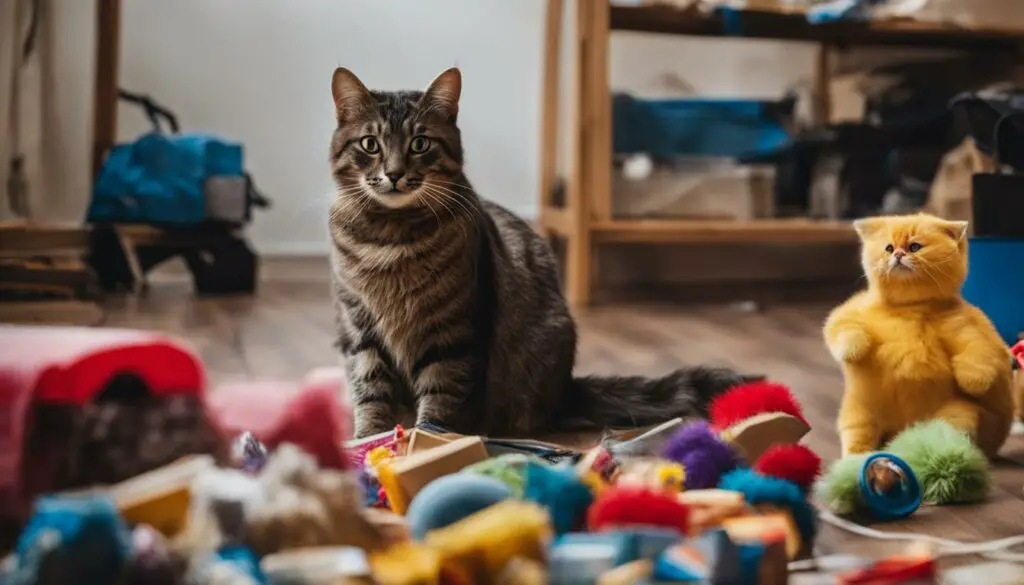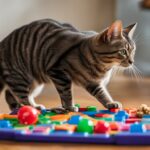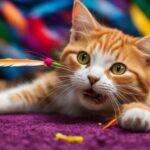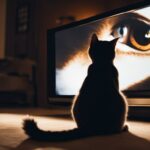Is your cat showing signs of boredom but refuses to engage in playtime? It can be frustrating and worrisome to see your feline friend disinterested in their usual activities. But fear not, there are plenty of fun solutions to try! In this article, I’ll share some stimulating cat activities and play ideas that can entertain even the pickiest of cats.
Indoor cats, as well as outdoor cats spending more time indoors during the colder months, are prone to boredom if they don’t have enough entertainment. That’s why it’s important to provide them with engaging and interactive experiences.
Key Takeaways:
- Recognize the signs of a bored cat, such as excessive meowing, overgrooming, and destroying furniture.
- Interactive play and toys, like fishing rod toys and puzzle feeders, can keep your cat entertained.
- Consider providing environmental enrichment, such as window perches and cat towers.
- Introducing another cat should be done carefully and with guidance.
- If your cat refuses to play, consult a vet to rule out any health issues.
Signs of a Bored Cat
As a cat owner, it’s important to be able to recognize the signs of a bored cat. These signs are indicators that your feline friend may be in need of more mental and physical stimulation. Some common signs of a bored cat include:
- Excessive meowing: If your cat is constantly meowing for attention, it could be a sign that they are bored and seeking stimulation.
- Zoomies: Zoomies refer to sudden bursts of energy where your cat darts around the house. While it can be entertaining to watch, it can also be a sign that your cat is bored and looking for an outlet for their energy.
- Overgrooming: Cats are known for their grooming habits, but excessive grooming can be a sign of boredom or stress.
- Destructive behavior: If your cat is scratching furniture, curtains, or other household items, it could be a sign that they are bored and in need of appropriate outlets for their natural behaviors.
It’s important to note that these signs can also be attributed to various other factors, so consulting your vet is crucial to rule out any underlying medical causes.
Table: Signs of a Bored Cat
| Signs | Explanation |
|---|---|
| Excessive meowing | Constantly meowing for attention |
| Zoomies | Sudden bursts of energy |
| Overgrooming | Excessive grooming habits |
| Destructive behavior | Scratching furniture, curtains, etc. |
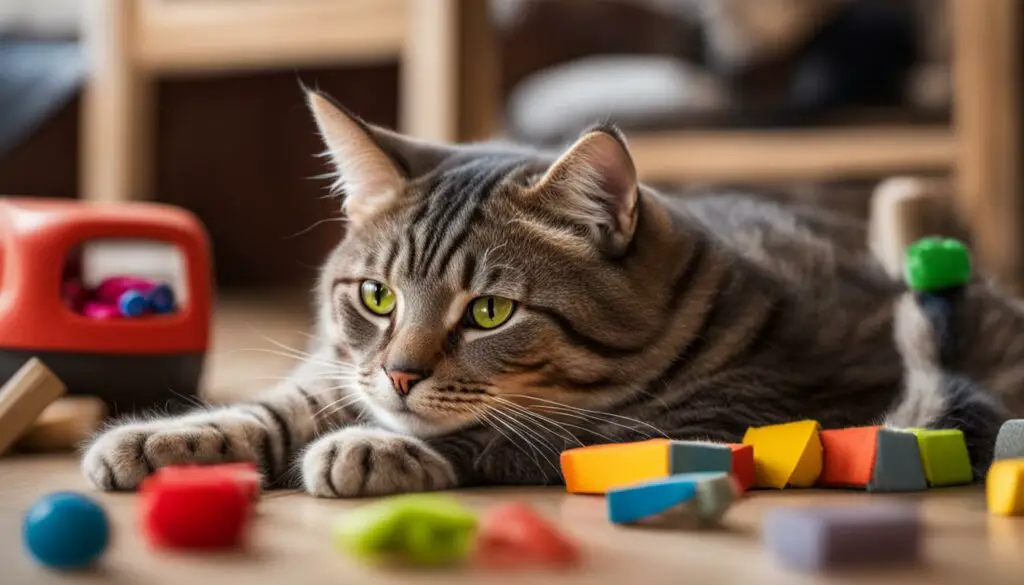
“A bored cat can exhibit various behaviors, such as excessive meowing, zoomies, overgrooming, and destructive behavior. These signs should not be ignored, as they can indicate a need for more mental and physical stimulation. Consulting with a veterinarian is essential to rule out any underlying medical issues.”
Interactive Play and Toys
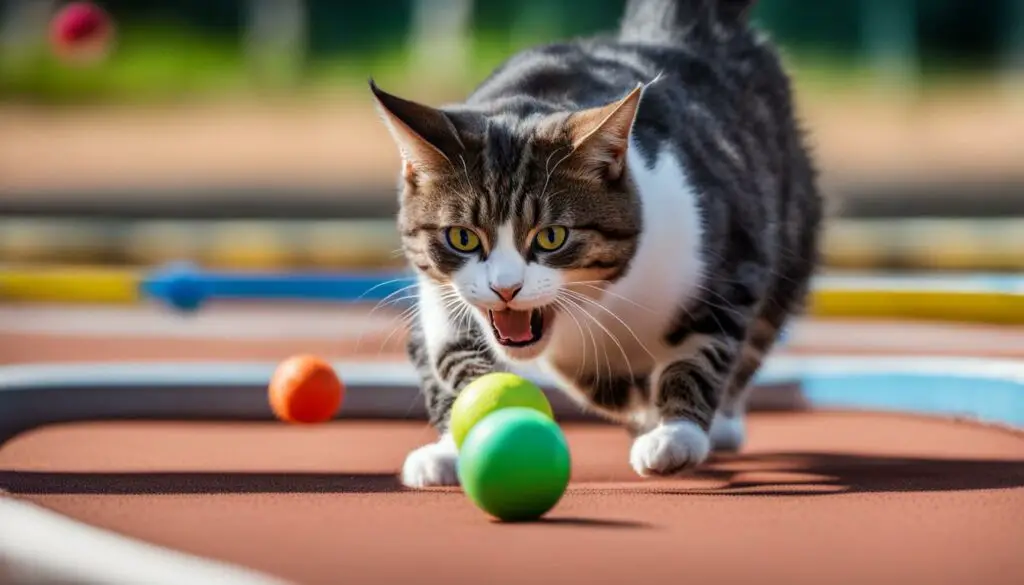
When it comes to keeping cats entertained, interactive play and toys are essential. Not only do they provide mental and physical stimulation, but they also foster a stronger bond between you and your feline friend. Interactive play allows cats to engage their natural hunting instincts and provides an outlet for their energy. By incorporating different types of toys and play techniques, you can keep your cat engaged and entertained for hours.
There are various types of interactive toys that can captivate your cat’s attention. Fishing rod toys with feathers or string attachments mimic the movements of prey and encourage your cat to pounce and chase. Kicker toys, which are long and stuffed with catnip or crinkle material, offer a satisfying sensory experience for your cat. Catnip and puzzle feeders provide mental stimulation and challenge your cat to work for their treats.
| Types of Interactive Toys | Benefits |
|---|---|
| Fishing rod toys | Mimics prey movements, stimulates hunting instincts |
| Kicker toys | Provides sensory stimulation, satisfies natural instincts |
| Catnip and puzzle feeders | Offers mental stimulation, encourages problem-solving |
| Ping pong balls | Provides hours of chasing and batting fun |
Experiment with different toys to find out what your cat enjoys the most. Some cats may prefer toys that stimulate their sense of sight and sound, while others may be more attracted to toys that engage their sense of smell and touch. It’s important to rotate toys regularly to avoid boredom and keep playtime exciting.
Playtime Tips:
- Schedule multiple short play sessions throughout the day
- Use a variety of toys to keep playtime interesting
- Observe your cat’s preferences and play style
- Engage in interactive play to strengthen your bond
Remember, interactive play and toys are a fun and effective way to keep your cat entertained and mentally stimulated. By incorporating these into your cat’s daily routine, you can promote their overall well-being and happiness.
Providing Environmental Enrichment
When it comes to keeping our feline friends entertained and engaged, providing environmental enrichment is essential. This means creating a stimulating environment that satisfies their natural instincts and keeps them mentally and physically active. There are several ways you can achieve this:
1. Letting Your Cat Explore the Great Outdoors Safely
If it is safe and feasible, allowing your cat some outdoor time can provide a wealth of sensory stimulation. Consider creating an enclosed outdoor space, like a catio, where your cat can experience the sights, sounds, and smells of nature without the risk of wandering off or encountering danger. This gives them the opportunity to climb, play, and explore, all while remaining safe and protected.
2. Creating a Window Perch with a View
Cats love to watch the world go by, and providing a comfortable window perch near a window with an interesting view can keep them entertained for hours. Whether it’s watching birds, squirrels, or passersby, the visual stimulation can prevent boredom and provide mental engagement for your cat.
3. Setting Up Vertical Spaces for Climbing
Cats are natural climbers, and vertical spaces can offer them both physical exercise and mental stimulation. Consider investing in a cat tower or installing shelves on the walls that your cat can explore and perch on. This not only provides entertainment but also allows your cat to survey their territory from a higher vantage point.
4. Training Your Cat for Mental Stimulation
Training your cat can be a fun and rewarding way to provide mental stimulation. Teaching them tricks, such as sitting, shaking paws, or jumping through hoops, challenges their minds and creates a bond between you and your feline companion. Use positive reinforcement techniques, such as treats or praise, to encourage and reward their efforts.
| Environmental Enrichment Ideas | Benefits |
|---|---|
| Provide puzzle feeders | Engages cats’ hunting instincts and adds mental stimulation during mealtime |
| Rotate and introduce new toys | Prevents toy fatigue and keeps cats interested in play |
| Offer scratching posts and different textures | Allows cats to engage in their natural scratching behavior and keeps their claws healthy |
| Hide treats or toys for cats to find | Provides a treasure hunt-like experience, stimulating their senses and problem-solving abilities |
Remember, each cat is unique, so it may take some trial and error to find the environmental enrichment activities that your cat enjoys the most. Observe their behavior and preferences to tailor their environment to their liking. By providing environmental enrichment, you can ensure that your cat stays entertained, mentally stimulated, and happy.
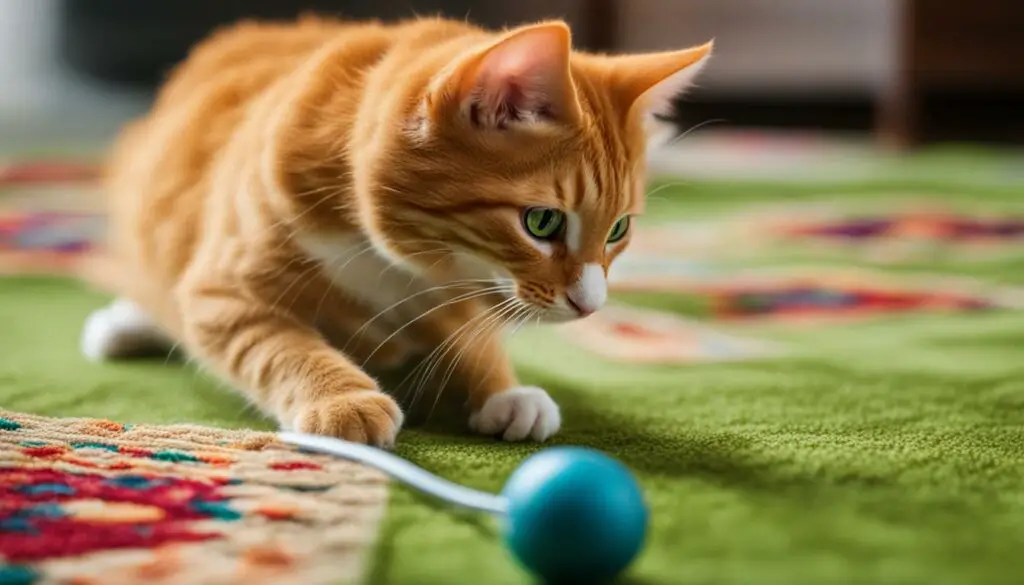
Considering Another Cat
If your cat is showing signs of boredom and you’re considering getting another cat, it’s important to approach this decision carefully. While the companionship of another cat can be beneficial for some cats, not all cats will get along. Introducing a new cat to your household should be done gradually and with proper guidance to ensure the best chance of success.
Before deciding to get another cat, consider your current cat’s personality and preferences. Some cats are more solitary and may become stressed or territorial with the presence of another cat. It’s important to assess whether your cat would truly benefit from a new feline companion or if there are other ways to address their boredom.
If you do decide to get another cat, make sure to introduce them slowly and in a controlled environment. Keep them separated at first and gradually allow them to interact under supervision. Provide separate resources, such as food bowls, litter boxes, and resting areas, to prevent any potential conflicts.
| Pros of Getting Another Cat | Cons of Getting Another Cat |
|---|---|
| The potential for increased companionship and playtime for both cats | Chance of the cats not getting along and creating a stressful environment |
| Opportunity for socialization and mental stimulation | The need for additional time, space, and resources to care for multiple cats |
| Possible reduction in boredom and destructive behavior | Potential for increased territorial behavior or marking |
Remember, getting another cat is not a guaranteed solution to your current cat’s boredom. It’s important to assess the compatibility of your cats and consider alternatives to keep your cat entertained, such as interactive toys, environmental enrichment, and dedicated playtime with you.
When to Consult a Vet
If your cat appears to be bored but is also not interested in play, it’s important to consider other possible underlying issues. Health issues can sometimes manifest as changes in behavior, including a lack of interest in play. If you’re concerned about your cat’s behavior, it’s always a good idea to consult with a vet who can determine if there are any underlying health issues that need to be addressed.
Some signs that may indicate it’s time to consult a vet include:
- Refusal or lack of interest in play
- Decreased appetite or sudden weight loss
- Excessive lethargy or sleeping more than usual
- Changes in litter box habits, such as frequent accidents or avoiding the litter box altogether
- Aggression or unusual aggression towards humans or other animals
A vet will be able to conduct a thorough examination and run any necessary tests to determine if there are any underlying medical conditions contributing to your cat’s lack of interest in play. They may also be able to provide guidance on behavioral changes or recommend specific treatments or therapies to address the issue.
| Signs to watch for when considering a vet visit | Possible underlying conditions |
|---|---|
| Refusal or lack of interest in play | Depression, pain, illness |
| Decreased appetite or sudden weight loss | Dental issues, gastrointestinal problems, organ dysfunction |
| Excessive lethargy or sleeping more than usual | Hormonal imbalances, infections, anemia |
| Changes in litter box habits | Urinary tract infections, bladder stones, kidney disease |
| Aggression or unusual aggression | Pain, anxiety, fear |
It’s always better to be safe than sorry when it comes to your cat’s health. Consulting with a vet can help ensure that any underlying issues are addressed and that your cat receives the appropriate care and treatment.
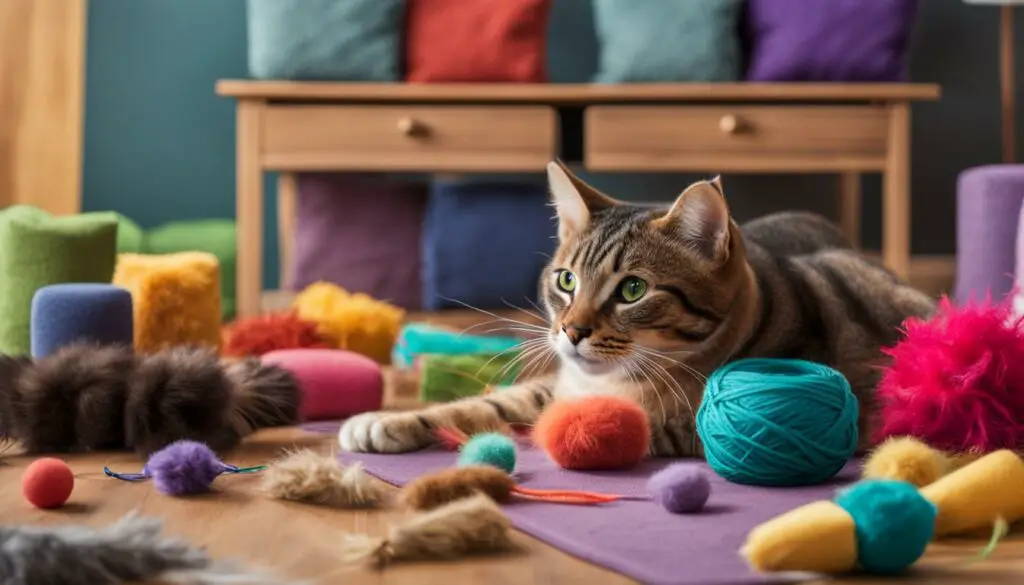
The Importance of Feeding Enrichment
Feeding enrichment plays a crucial role in keeping cats entertained and mentally stimulated during mealtime. Just like humans, cats can get bored with the same food and eating routine day after day. By introducing variety and interactive feeding techniques, you can make mealtime more exciting for your feline friend.
One way to provide feeding enrichment is through puzzle feeders. These are interactive toys or puzzles that require your cat to work for their food. They are designed to stimulate their natural hunting instincts and provide mental stimulation. Puzzle feeders can be filled with dry kibble or treats, and your cat will have to figure out how to maneuver the puzzle to access their food. This not only adds an element of fun to mealtime but also slows down their eating, which can be beneficial for cats prone to eating too quickly.
Another way to incorporate feeding enrichment is by offering a variety of flavors and textures in your cat’s diet. Just like humans, cats can develop preferences for certain flavors and textures. By rotating different types of wet food or offering a mix of dry and wet food, you can keep their taste buds satisfied and prevent them from getting bored with their meals. It’s important to make any dietary changes gradually to avoid upsetting your cat’s stomach.
In addition to puzzle feeders and variety in their diet, you can also make mealtime more exciting by engaging with your cat during feeding. Use interactive toys or play with them while they eat to create a positive association with mealtime. This can also help burn off some energy and prevent them from getting bored once they finish their food.
| Benefits of Feeding Enrichment | Examples of Feeding Enrichment |
|---|---|
|
|
Feeding enrichment is an important aspect of cat care that can help prevent boredom and keep your cat mentally and physically engaged. By incorporating puzzle feeders, offering a variety of flavors, and engaging with your cat during mealtime, you can make feeding time a fun and stimulating experience for your furry friend.
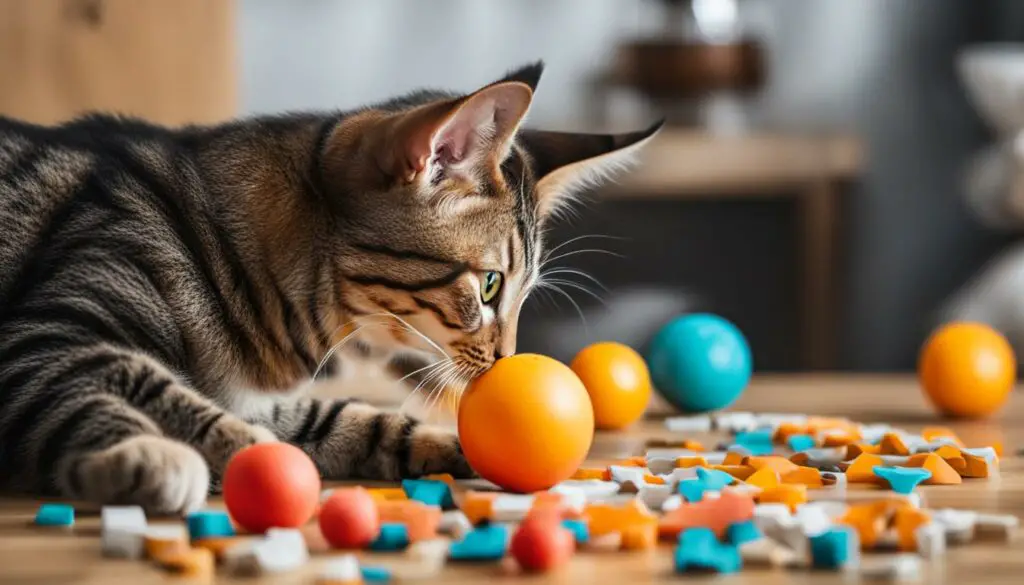
Addressing Playtime Challenges
As a cat owner, I understand that sometimes our busy schedules can make it difficult to find time for playtime with our feline friends. However, even if you’re short on time, there are still ways to provide stimulation and engage your cat in interactive play.
One solution is to invest in interactive toys or puzzle feeders. These toys are designed to keep cats entertained even when we’re not available to play with them. They often have hidden treats or toys that cats can discover and play with on their own. It’s a great way to keep your cat mentally and physically stimulated, even when your schedule is packed.
Another option is to take just a few minutes each day to engage in active play with your cat. Set aside a specific time, whether it’s in the morning or evening, and make it a routine. Use toys that your cat loves, such as a feather wand or a laser pointer, and get them moving and jumping. This short burst of playtime can go a long way in preventing boredom and keeping your cat happy and healthy.
Remember, every cat is unique, so it’s important to find what works best for your furry friend. Experiment with different toys, play styles, and schedules to see what captures your cat’s interest. With a little creativity and effort, you can address playtime challenges and ensure that your cat remains engaged and entertained.
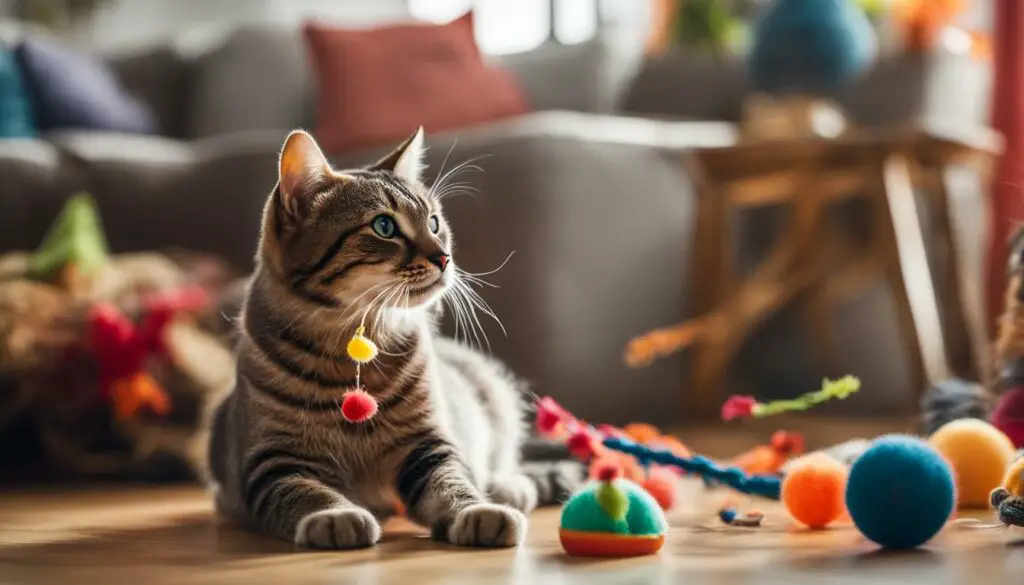
Engaging Cats in Play
When it comes to playtime, it’s important to find activities that truly engage your cat. Some cats may prefer toys that involve chasing and pouncing, while others may enjoy more interactive play, such as hunting or scratching. Observe your cat’s behavior and preferences to determine what type of play they enjoy the most.
Additionally, providing a stimulating environment can enhance your cat’s playtime. Set up climbing structures, scratching posts, and hiding spots to create an interactive space for your cat. Rotate and introduce new toys regularly to keep playtime exciting and prevent boredom.
By addressing playtime challenges and finding ways to engage your cat in interactive play, you can ensure that they stay mentally and physically stimulated, even with a busy schedule. Remember to make playtime a priority and enjoy the bonding moments with your furry companion.
Understanding Your Cat’s Play Preferences
Just like humans, cats have their own unique play preferences. Understanding what types of play your cat enjoys can help you create a more engaging and entertaining playtime experience. Some cats may prefer interactive play, such as chasing toys or engaging in play sessions with their owners, while others may enjoy independent play with toys they can bat around on their own.
To determine your cat’s play preferences, observe their behavior during playtime. Take note of the types of toys and play styles that capture their interest the most. Does your cat prefer toys that mimic their natural hunting instincts, like feather wands or toys that can be “pounced” upon? Or do they prefer toys that they can paw and bat around, such as small balls or crinkly toys?
Experiment with different types of toys and play styles to discover what your cat enjoys the most. Set aside dedicated playtime each day to engage in play that aligns with their preferences. Remember, cats are individuals, and what one cat enjoys, another may not. By catering to your cat’s play preferences, you can ensure they have a fun and fulfilling playtime experience.
Engaging Toys for Different Play Preferences
Here are some examples of toys that cater to different play preferences:
- For cats who enjoy interactive play and chasing toys, try fishing rod toys with feathers, strings, or small plush toys attached. These toys can simulate the thrill of hunting and provide an opportunity for you to engage in play with your cat.
- If your cat prefers independent play, consider toys that they can bat, swat, and bathe around on their own. Small balls, crinkle toys, and catnip-filled toys are all great options for independent play.
- Cats who enjoy the thrill of the hunt may appreciate puzzle toys that require them to “capture” their prey by pawing or manipulating the toy to release treats or kibble. These toys provide mental stimulation and tap into their natural instincts.
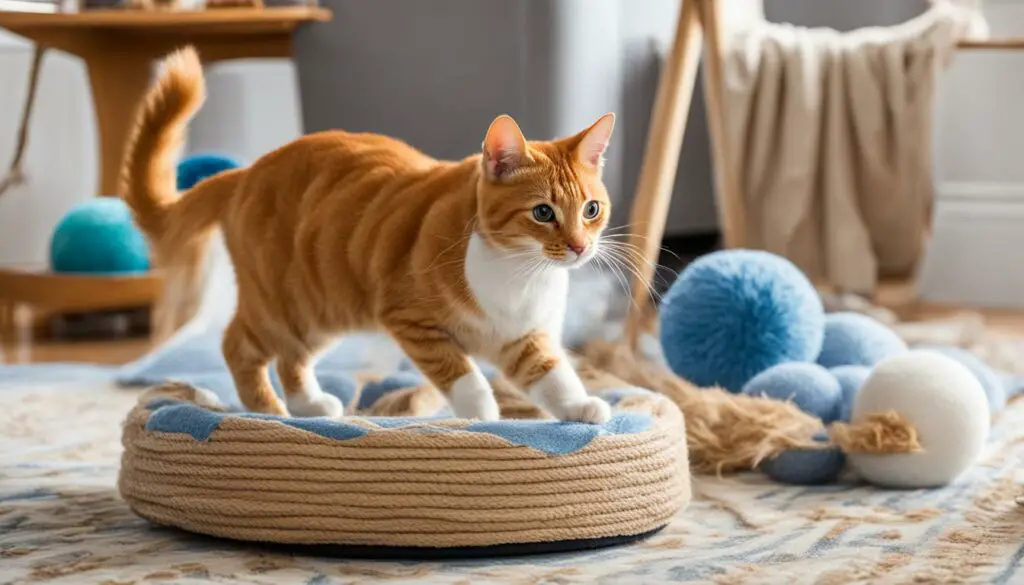
Remember to keep safety in mind when selecting toys for your cat. Choose toys that are size-appropriate and free of small parts that could be swallowed. Supervise your cat during playtime to ensure they are safely enjoying their toys.
Dealing with a Cat That Won’t Play
If your cat is showing signs of boredom but won’t engage in play, there could be underlying reasons for their lack of interest. It’s important to rule out any health issues by consulting a vet. A cat’s lack of play behavior may be due to physical discomfort or pain, so it’s crucial to address any potential medical issues before attempting to encourage play.
In some cases, a cat may simply have different play preferences or may not be interested in the toys or play techniques you have provided. Observing your cat’s behavior and preferences can help you identify what types of play or toys they are more inclined to enjoy. Try out different types of toys and play styles to find what captures your cat’s interest and keeps them entertained.
Additionally, try to create a stimulating environment for your cat by providing interactive toys, scratching posts, and hiding spots. Cats are naturally curious and enjoy exploring their surroundings, so having a variety of options for play and exploration can help prevent boredom. Rotate and introduce new toys periodically to keep the play experience fresh and exciting for your cat.
| Tip | Quote |
|---|---|
| 1. Evaluate your cat’s health |
|
| 2. Observe your cat’s preferences |
|
| 3. Provide a stimulating environment |
|
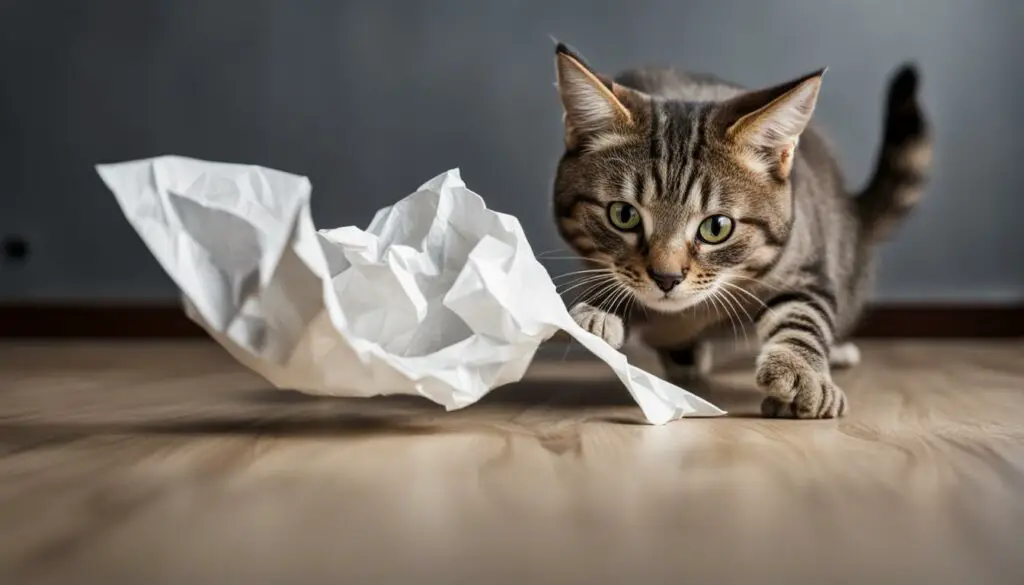
- Evaluate your cat’s health: If your cat isn’t playing, it’s important to make sure there are no underlying health issues. Pain or discomfort may be preventing your cat from engaging in play behavior.
- Observe your cat’s preferences: Every cat is unique, so it’s essential to pay attention to your cat’s preferences when it comes to play. Some cats may prefer interactive toys, while others may enjoy chasing or pouncing on objects. Experiment with different toys to see what captures your cat’s interest.
- Provide a stimulating environment: Cats thrive in environments that offer opportunities for exploration and play. Make sure to provide interactive toys, scratching posts, and hiding spots to keep your cat entertained. Rotating and introducing new toys can also help prevent boredom.
Tips for Making Playtime More Exciting
Playtime is an essential part of keeping our cats happy and engaged. If you’re looking to make playtime more exciting for your furry friend, here are some tips to consider:
- 1. Vary the types of toys: Cats can easily get bored with the same toys day after day. Add variety by offering different types of toys, such as interactive puzzle toys, feather wands, and crinkle balls. This will keep your cat interested and engaged during playtime.
- 2. Incorporate different play styles: Cats have different play preferences, so it’s important to offer a variety of play styles. Some cats love to chase and pounce, while others prefer to stalk and ambush. Experiment with different play styles to see what your cat enjoys the most.
- 3. Introduce new interactive toys: Keep playtime exciting by introducing new interactive toys regularly. This could be a treat-dispensing toy or an electronic toy that mimics the movement of prey. These toys can provide mental stimulation and mimic the thrill of hunting for your cat.
- 4. Create an engaging play environment: Cats are natural climbers and explorers. Set up a cat tree or create vertical spaces with shelves where your cat can climb and perch. This will not only provide physical exercise but also give your cat a sense of adventure during playtime.
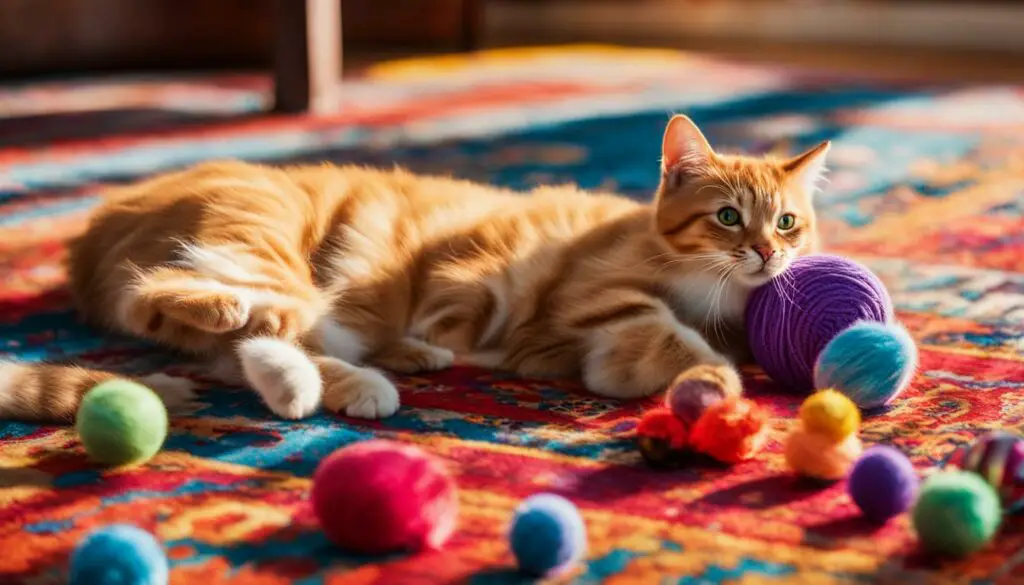
“Playtime is one of the best ways to bond with your cat and provide them with the mental and physical stimulation they need. By incorporating these tips into your playtime routine, you’ll create an exciting and engaging experience for your feline friend.”
Examples of Engaging Cat Play Ideas
Looking for some specific play ideas to make playtime more exciting? Here are a few examples to get you started:
| Play Idea | Description |
|---|---|
| Treat Hunt | Hide treats around the house and let your cat use their hunting instincts to find them. This provides mental stimulation and keeps them active. |
| Obstacle Course | Create a DIY obstacle course using pillows, tunnels, and boxes. Encourage your cat to navigate through the course, rewarding them with treats or praise. |
| Bubble Chase | Blow bubbles for your cat to chase. This can be a fun and interactive way to get them moving and provide entertainment. |
| Interactive Laser Pointer | Use a laser pointer to create an engaging play session. Just make sure not to shine the laser directly into your cat’s eyes. |
Remember, the key to making playtime more exciting is to keep it varied, interactive, and engaging for your cat. By providing a stimulating environment and offering a variety of play styles and toys, you’ll ensure that your cat stays entertained and happy during playtime.
Understanding the Cat’s Natural Instincts
As cat owners, it’s important to recognize and understand our feline companions’ natural instincts. Cats are born hunters, and their instincts drive them to stalk, chase, and catch prey. By tapping into these instincts during playtime, we can provide a more engaging and stimulating experience for our cats.
Interactive play that mimics hunting behavior is particularly effective in capturing a cat’s interest. Toys that allow cats to pounce, jump, and “capture” their prey, such as feather wands or laser pointers, can provide hours of entertainment. This type of play not only satisfies their natural instincts but also helps keep them physically active and mentally stimulated.
It’s important to note that each cat may have different preferences when it comes to play. Some cats may enjoy chasing toys that mimic small prey like mice, while others may prefer toys that allow them to engage in more physical play, such as scratching posts or tunnels. Observing your cat’s behavior during playtime can help you understand their specific instincts and tailor the play experience to their liking.
Cat Instincts and Interactive Play
Cats have a strong prey drive, and interactive play is the perfect way to engage their instincts. By incorporating interactive toys that encourage stalking, chasing, and pouncing, we can provide a more enriched play experience for our cats. Not only does this type of play satisfy their natural instincts, but it also helps prevent boredom and promotes a healthier, happier cat.
It’s important to remember that interactive play should be supervised to ensure the safety of both the cat and their human playmate. Avoid using toys with small parts that could be swallowed, and always allow your cat to “catch” their prey occasionally to keep the play experience rewarding for them.
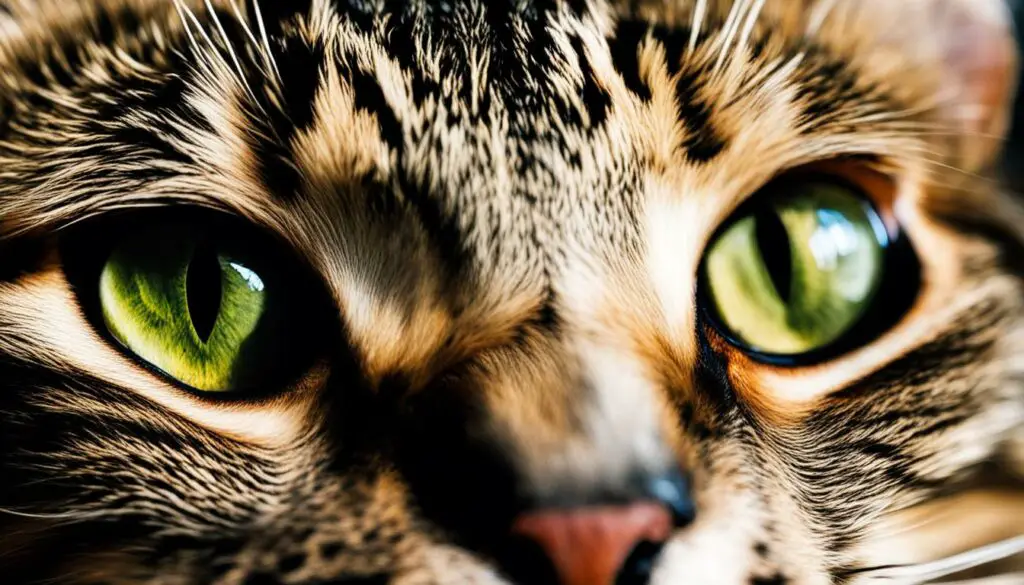
Understanding and tapping into your cat’s natural instincts can greatly enhance their playtime experience. By providing toys and play opportunities that mimic their hunting behaviors, you can keep your cat mentally stimulated, physically active, and entertained. So the next time you engage in play with your feline friend, remember to cater to their natural instincts and watch as they unleash their inner hunter!
The Role of Environmental Enrichment
When it comes to keeping cats entertained and preventing boredom, environmental enrichment plays a crucial role. Providing a stimulating environment is essential for the overall well-being of cats and can help prevent undesirable behaviors that may arise from boredom. By incorporating various elements into their surroundings, we can create an engaging and fulfilling environment for our feline friends.
The Benefits of Environmental Enrichment
Environmental enrichment offers numerous benefits for cats. It provides mental and physical stimulation, allowing them to engage their natural instincts and keep their minds and bodies active. Engaging activities and objects can reduce stress, prevent destructive behaviors, and promote overall happiness and contentment. By offering a range of options for play, exploration, and relaxation, we can create a space that meets our cat’s individual needs.
Creating a Stimulating Environment
To create an enriched environment for your cat, consider incorporating the following elements:
- Scratching posts or boards: Provide multiple scratching surfaces to satisfy their natural instinct to scratch and stretch.
- Interactive toys: Offer a variety of toys that encourage play and mental stimulation, such as puzzle toys or treat-dispensing toys.
- Hiding spots: Create cozy hiding spots using cat beds, boxes, or cat trees to give your cat a sense of security and a place to retreat.
- Vertical space: Install shelves or cat trees to allow your cat to climb and perch at different heights, mimicking their natural inclination for height and observation.
| Benefits of Environmental Enrichment | Creating a Stimulating Environment |
|---|---|
| • Mental and physical stimulation | • Scratching posts or boards |
| • Reduction of stress | • Interactive toys |
| • Prevention of destructive behaviors | • Hiding spots |
| • Promotion of overall happiness | • Vertical space |
“Environmental enrichment offers numerous benefits for cats. It provides mental and physical stimulation, allowing them to engage their natural instincts and keep their minds and bodies active.”
Remember to regularly rotate toys and provide new stimuli to maintain your cat’s interest. Additionally, spending quality time engaging with your cat through play and interaction is crucial for their well-being. By creating a stimulating environment, we can ensure that our feline companions lead happy, fulfilled lives free from boredom.
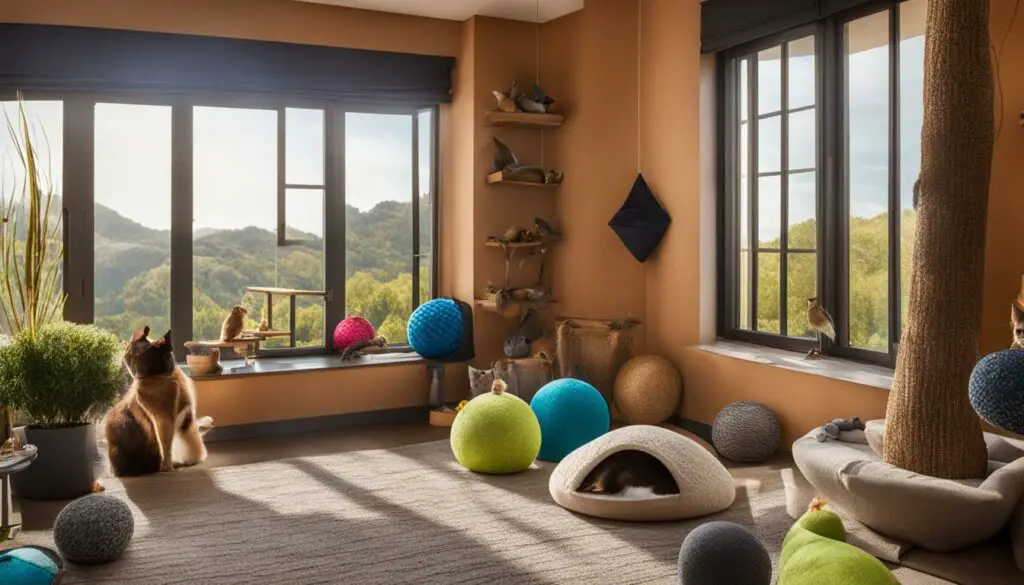
Creating a Play Routine
Establishing a consistent play routine is essential for keeping your cat engaged and preventing boredom. Cats thrive on routine and knowing when playtime will occur can help them anticipate and look forward to these sessions. Set aside dedicated playtime each day and stick to a schedule that works for both you and your cat. Consistency is key to maintaining a healthy play routine.
During playtime, try incorporating a variety of play techniques and toys to keep things interesting. Cats have different play preferences, so it’s important to offer a range of options to cater to their individual tastes. Some cats may prefer chase and pounce games, while others may enjoy interactive toys that mimic hunting behavior. Observe your cat’s reactions to different types of play and adjust accordingly.
Remember to use a variety of toys during playtime. Cats can quickly become bored with the same toys, so rotate them regularly to keep things fresh. Introduce new toys periodically to spark your cat’s curiosity and excitement. This can help prevent your cat from losing interest in play and keep them mentally and physically stimulated.
| Benefits of a Play Routine | Tips for a Successful Play Routine |
|---|---|
|
|
“A consistent play routine is not only beneficial for your cat’s physical and mental well-being but also strengthens the bond between you and your furry friend. By setting aside dedicated time for play, you are showing your cat that they are a valued member of the family and providing them with the stimulation they need to thrive.”
Remember to observe your cat’s energy levels and adjust the duration and intensity of play accordingly. Some cats may prefer shorter, more frequent play sessions, while others may enjoy longer play sessions. Pay attention to your cat’s cues and let their energy level guide the length of playtime. Always end play sessions on a positive note to leave your cat feeling satisfied and content.
By creating a play routine that is tailored to your cat’s needs and preferences, you can ensure that they stay engaged, entertained, and happy. Playtime is not only a way to keep your cat physically active but also provides them with mental stimulation and helps prevent boredom. So gather your cat’s favorite toys, set aside some dedicated playtime, and enjoy the benefits of a play routine for both you and your feline friend.
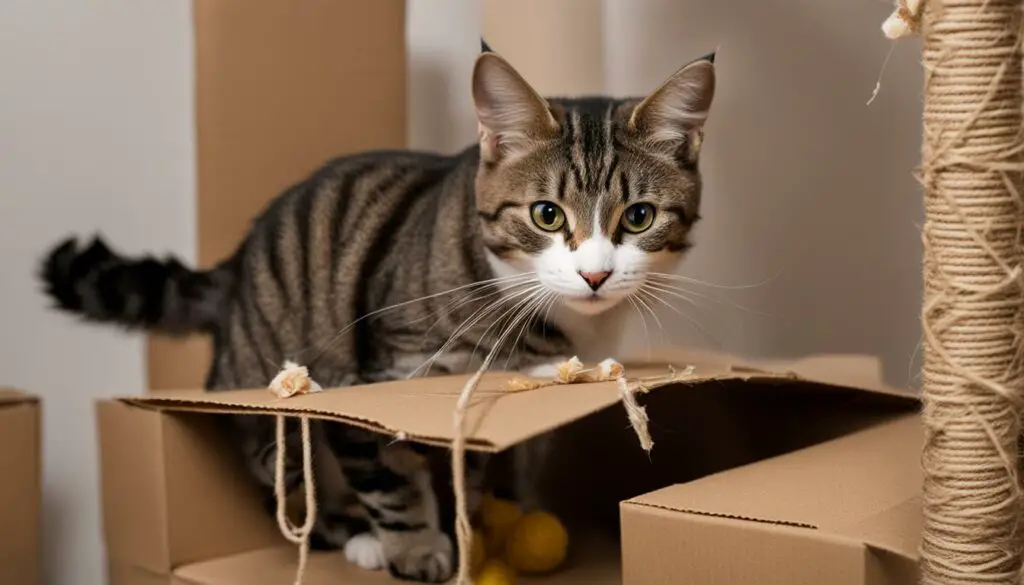
Encouraging Independent Play
While interactive play with your cat is important, it’s also beneficial to encourage independent play. Providing toys that can be self-played, such as puzzle feeders, balls, and interactive electronic toys, can keep your cat entertained when you’re not available. Cats have a natural instinct to hunt and play, and independent play can help satisfy these instincts even when you’re not around. It also provides mental and physical stimulation, preventing boredom and promoting a healthy lifestyle for your feline friend.
One popular option for independent play is puzzle feeders. These toys allow your cat to work for their food by batting, rolling, or manipulating the toy to release the treats or kibble inside. Not only does this keep them entertained, but it also helps slow down their eating and promotes natural hunting behaviors. Puzzle feeders come in various designs, so you can choose one that suits your cat’s skill level and preferences.
Another option is interactive electronic toys. These toys are designed to engage your cat’s senses with movements, sounds, and lights. Cats are instinctively attracted to these stimuli, making electronic toys a great way to keep them entertained when you’re busy or not at home. These toys often have automatic timers or motion sensors, so they activate when your cat interacts with them and turn off when they lose interest.
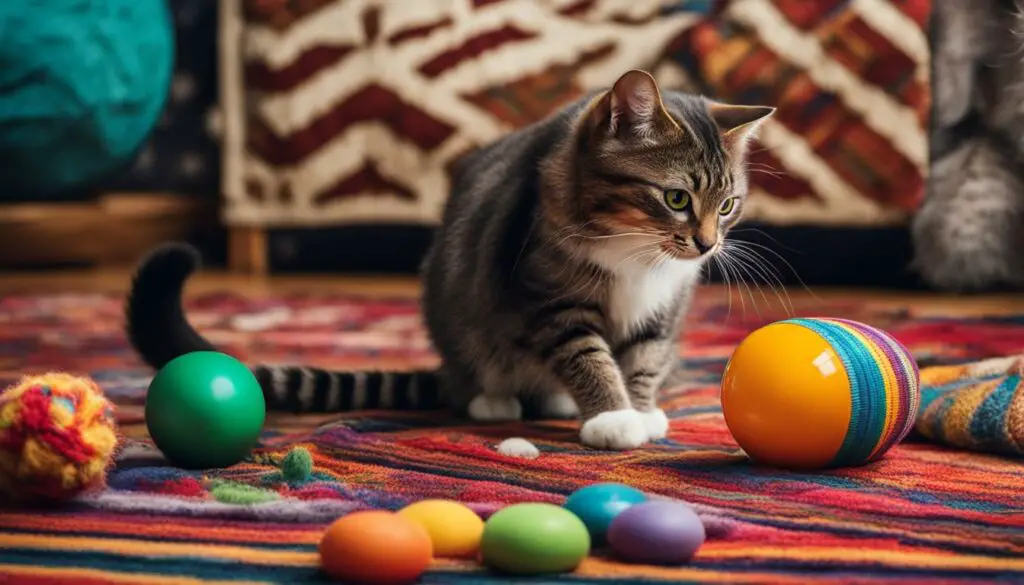
Engaging Cat Toys for Independent Play
| Toy | Description |
|---|---|
| Puzzle Feeder | A toy that dispenses treats or kibble when your cat interacts with it. |
| Electronic Mouse Toy | A toy that mimics the movement of a mouse, appealing to your cat’s hunting instincts. |
| Ball Tower | A tower with multiple levels where your cat can bat a ball down the levels, providing mental and physical stimulation. |
| Fish Kicker Toy | A plush toy designed like a fish that your cat can kick and wrestle with. |
When introducing toys for independent play, it’s important to rotate them regularly to keep your cat’s interest. Cats can quickly become bored with the same toys, so having a variety to choose from will prevent them from losing interest. Additionally, always supervise your cat’s playtime and ensure that the toys are safe and durable, without any small parts that could be swallowed.
Encouraging independent play is not only a great way to keep your cat entertained, but it also provides mental and physical stimulation, promoting a happy and healthy lifestyle. By providing puzzle feeders, interactive electronic toys, and other engaging toys, you can ensure that your cat has plenty of opportunities for play and exploration, even when you’re not available to interact with them.
Conclusion
In conclusion, if you find that your cat is bored but won’t play, there are several strategies you can try to engage and entertain them. It’s important to understand the signs of a bored cat, such as excessive meowing, overgrooming, or destructive behavior, and address any underlying health issues with the help of a vet.
Interactive play and toys play a key role in keeping cats entertained. Experiment with different types of toys, such as fishing rod toys or puzzle feeders, to discover what your cat enjoys the most. Additionally, providing environmental enrichment through options like window perches, climbing structures, and cat grass can stimulate their instinctual behaviors.
If your cat is not interested in play, it’s crucial to rule out any medical issues. Consulting with a vet can help identify and address any underlying health problems. Finally, establishing a play routine and encouraging independent play can ensure that your cat stays engaged and entertained even when you’re not available.
Remember, each cat is unique, and understanding their individual preferences is key to providing the most engaging play experiences. With a combination of interactive play, environmental enrichment, and attention to their needs, you can help alleviate boredom and keep your cat happy and entertained.
FAQ
What are the signs of a bored cat?
Signs of a bored cat can include zoomies, excessive meowing, sleeping a lot, pacing, overgrooming, overeating, destroying furniture and furnishings, and attacking humans and other animals.
How can I keep my cat entertained through interactive play?
You can keep your cat entertained through interactive play by using fishing rod toys, kicker toys, catnip and puzzle feeders, and ping pong balls. Remember to change up the toys you use to keep it interesting for your cat.
What can I do to provide environmental enrichment for my cat?
You can provide environmental enrichment for your cat by creating an enclosed outdoor space like a catio, setting up a window perch near a window with an interesting view, growing cat grass indoors, and setting up a cat tower or shelves for climbing.
Should I consider getting another cat to keep my bored cat company?
While getting another cat may seem like a solution, it’s important to approach this carefully. Cats are naturally solitary animals, and not all cats will get along. Introducing a new cat should be done gradually and with proper guidance to ensure the best chance of success.
When should I consult a vet about my cat’s behavior?
If you notice changes in your cat’s behavior and suspect boredom, it’s important to consult a vet to rule out any underlying medical issues. They can determine if there are any health concerns that need to be addressed.
How can feeding enrichment help prevent boredom in cats?
Feeding enrichment can help prevent boredom in cats by providing them with the challenge of working for their food through puzzle feeders. Adding variety to your cat’s diet with different flavors and textures can also help prevent boredom.
What can I do to address playtime challenges when I have a busy schedule?
If you’re struggling to find time to play with your cat, you can use interactive toys or puzzle feeders that can engage your cat even when you’re not available. Taking a few minutes each day to engage in active play with your cat can also go a long way in preventing boredom.
How can I understand my cat’s play preferences?
Understanding your cat’s play preferences involves observing their behavior and preferences. Trying out different types of toys and play styles can help you find what your cat enjoys the most.
What should I do if my cat won’t play?
If your cat won’t play, it’s important to consult a vet to rule out any health issues that could be causing their lack of interest. Additionally, paying attention to your cat’s play behavior and preferences can help you determine if there are specific types of play or toys that they are more inclined to enjoy.
How can I make playtime more exciting for my cat?
You can make playtime more exciting for your cat by varying the types of toys you offer, incorporating different play styles, and introducing new interactive toys. Experimenting with different play techniques and toys can help keep your cat engaged and entertained.
Why is understanding my cat’s natural instincts important for playtime?
Understanding your cat’s natural instincts, such as their hunting instincts, can help make playtime more engaging and enjoyable for them. Incorporating toys that allow your cat to stalk, chase, and “catch” their prey can provide a more satisfying play experience.
How important is environmental enrichment for my cat?
Environmental enrichment plays a crucial role in keeping cats entertained and preventing boredom. Providing a variety of toys, scratching posts, climbing structures, and hiding spots can create a stimulating environment for your cat.
How can I establish a play routine for my cat?
Establishing a consistent play routine can help keep your cat engaged and prevent boredom. Set aside dedicated playtime each day and stick to a schedule. Tailor the play routine to your cat’s preferences and incorporate a variety of play techniques and toys.
How can I encourage independent play in my cat?
You can encourage independent play in your cat by providing toys that can be self-played, such as puzzle feeders, balls, and interactive electronic toys. Remember to rotate and introduce new toys to keep the play experience fresh and exciting for your cat.

